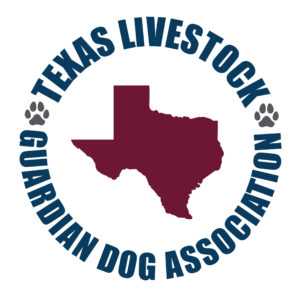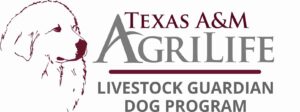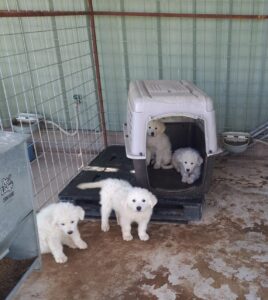 The Texas LGD Association had its fifth anniversary last month. While it was a rocky start due to COVID-19, the association has steadily grown in membership each year and elected new board members in January. The association is made up of LGD breeders and producers. It was initially designed to be a Texas organization, but now includes members and breeders across the US! We encourage all LGD breeders and ranchers to join the organization. One of its goals is to work against legislative issues in the state that could hinder the effective use of LGDs for ranchers. If you want to join the association, please use this link to the association’s website.
The Texas LGD Association had its fifth anniversary last month. While it was a rocky start due to COVID-19, the association has steadily grown in membership each year and elected new board members in January. The association is made up of LGD breeders and producers. It was initially designed to be a Texas organization, but now includes members and breeders across the US! We encourage all LGD breeders and ranchers to join the organization. One of its goals is to work against legislative issues in the state that could hinder the effective use of LGDs for ranchers. If you want to join the association, please use this link to the association’s website.
If you have not visited our Facebook page recently, you have been missing our new posts. We are now posting almost daily on Facebook and Instagram. Each week, we have new, updated posts on training tips, health tips, and facts. You can follow us online @TAMUlivestockguarddog on Facebook, Instagram, and YouTube.
The Texas Sheep and Goat Raisers Association and the Sheep and Goat Predator Management Board hosted a Trapping Clinic again this year. The event was held on April 11-12 in El Dorado at the X Bar Ranch. I attended the event last year and again this year and learned a lot of valuable information about predator control. I strongly encourage everyone involved in predator control and ranching to attend next year’s event.
AgriLife Livestock Guardian Dog Program: Update and Events
SAVE THE DATE! We will host the 9th Annual AgriLife LGD Field Day at the AgriLife Center in San Angelo on May 2nd from 8 a.m. to 4 p.m. The event will feature four workshops, a producer panel, and a ranch tour. Presenters for the event will include Dr. John Tomecek (AgriLife Wildlife Specialist) and Dr. Walter Burghardt (Canine Behaviorist). Vendors and dog breeders will be present. Lunch and morning refreshments will be provided. Follow our social media pages, TAMUlivestockguarddog, for more information. Check the events page on our website to register for the event!
Feeding LGDs
Feeding LGDs by hand can be time-consuming, but it allows you to do health checks and socialize your dog regularly. Self-feeding is much easier and less time-consuming. However, it creates a feed source for varmints and livestock. This month, we will start a two-part series on what to feed, how to feed, and problems to avoid when feeding an LGD.
What should an LGD Be Fed?
LGD breeds should be fed high-quality commercial food; alternatively, if there is time in the day and nutrition knowledge, they can have a carefully balanced raw diet. However, few people have that time and expertise, so we recommend purchasing a quality commercial kibble with animal protein as the first ingredient. LGDs have historically lived on marginal diets, and small property owners must be careful not to overfeed their dogs. LGDs working on large ranches are rarely overweight, as they burn many calories daily.
LGD Nutrition and Health
Whether it is a large Pyrenees Mastiff or a smaller Maremma, all breeds of LGDs were traditionally bred to thrive on a minimal diet. While they are large dog breeds requiring substantial food, feeding them appropriately is important. Healthy adult LGDs should exhibit a lean appearance. A healthy dog will have a defined waist, as indicated by Nestle Purina’s body condition scoring system. Body condition scoring is the simplest way to determine whether an LGD is properly weighed. If used regularly, producers can accurately assess the dog’s appropriate BCS and make necessary dietary adjustments.
Puppies must be kept within a healthy weight range. It is preferable for them to be slightly overweight rather than underweight, as they can overgrow and become too thin if they do not receive enough food. Large-breed dogs should grow slowly to mitigate the risk of health problems later. The main concerns are osteochondrosis, hip dysplasia, elbow dysplasia, and panosteitis.
elbow dysplasia, and panosteitis.
Osteochondrosis in dogs is a general failure of cartilage to develop properly, which can lead to osteochondritis dissecans. It is considered an inherited disorder, but other factors, such as trauma, rapid growth, and nutrition, may also contribute. Symptoms include joint pain, lameness, and reduced movement. Hip dysplasia in dogs is marked by abnormal hip joint development, resulting in pain and permanent joint damage. Elbow dysplasia in dogs is less common but causes swelling, pain, and eventually arthritis in the elbows of LGDs. Irregular development of the bones in the elbow joint leads to uneven weight distribution, resulting in lameness and arthritis.
Panosteitis is a painful bone condition in dogs that affects the long leg bones of young large breed dogs. It is also known as “growing pains” and typically occurs between the ages of 5 and 18 months. The inflammation may involve one or multiple bones and can cause intermittent lameness. If feeding a commercial kibble, buy ‘large breed’ puppy and dog food for the LGDs. This will help maintain their growth and weight while decreasing the chances of the diseases listed above.
What to Feed LGD Breeds: Commercial Vs. Raw Dog Food
The debate over commercial food versus raw food is significant among dog owners. The foundation of raw food diets is that wild canines consume raw food. Since dogs are closely related to wild canines, their optimal diet should also consist of raw foods. While many LGD owners advocate raw food diets, we believe that this may not be the best approach. We strongly recommend consulting a veterinarian or canine nutritionist to safely and effectively implement this diet. Others contend that domesticated dogs possess a digestive system sufficiently different from their wild ancestors, making it unreasonable to assume they should follow the same diet.
Dogs’ digestive systems are tailored to a more varied diet because they have been domesticated for thousands of years. Science has shown that their digestive and body systems have evolved to require more carbohydrates than their wild canine relatives. A balanced approach is the best diet for LGDs. If raw meat is available to supplement their commercial kibble during the year after hunting season or when livestock are butchered, feed it! If not, we do not suggest purchasing raw feed for an LGD.
We feed high-quality, mid-level protein, high-fat commercial kibble to our LGDs at the Center. Since adopting this ratio, our dogs have never looked better, are more active, and have fewer health issues. The old saying, “You get what you pay for,” applies to dog food, just like it does for livestock feed. You would likely not feed show animals only corn, so do not feed low-quality kibble from a large chain store. Dogs fed low-quality feed will be less active, leading to lower protection levels and more livestock predation.
We will conclude this article next month in the May issue of The Guardian Way.
Bonding Project Update
Round Six
Round six pups are healthy and doing well. We had an issue with Lilly about 10 days after placing her on the Menard ranch. In mid-March, she decided to roam off the ranch. Lilly traveled almost five miles east towards Hwy 83 one morning. She was within ¾ of a mile of the highway before she stopped, and we got her from a neighbor’s ranch. We returned Lilly that day to San Angelo for kennel punishment. She was kenneled for several days and returned to a pasture at the Center for observation and retraining with an invisible fence collar. After that, Lilly was placed with some sheep and has been placed at the Read Ranch in Ozona. She has been doing well at the new location on her own.

Lilly’s roaming pattern in March of 2025. Black outline is the Martin Ranch Boundary. AgriLife picture courtesy Costanzo 2025.
The pups in Mc Camey have not caused any teenage problems for the producer yet. Dasher was recently picked up from the producer in Ozona for retraining, as he had killed two newborn lambs. The kill was confirmed to be his because the ranch hand had gone to lunch while the lambs were alive. He returned from lunch 45 minutes later and found Dasher eating them. We brought Dasher back to the Center the next day for retraining, as this type of behavior can get out of hand quickly and lead to prey drive in a dog that should not have any predatory instincts.
The best way to stop this type of adolescent behavior is with an E-collar. Dasher will be placed in a pen with an E-collar on and add some young lambs. He will be observed from a distance, and anytime he goes near the lambs, we will shock him at the highest setting. We observe from a distance so that the dog does not think the shock is caused by humans. We want him to believe the shock is caused by the lambs. He will not be shocked if he approaches an adult animal since he is not chasing or chewing on ewes or rams. The training will be performed daily for approximately 15 minutes for 10 days.
Round Seven
We have secured four Maremma puppies for the cattle bonding project in round seven. They arrived on April 6th to
start the project. A separate set of pens will be used for the cattle bonding project, so this time there will also be a set of puppies bonded with sheep and goats for AgriLife use.
The puppies will be bonded in pairs, this time within pens surrounded by hot wire at the base. Since we are bonding with weaned calves, the puppies will be placed in an enclosure next to the cattle feeder for the first 30 days to prevent injury. This will keep them safe while allowing the pups to be exposed to the calves during feeding. The pups in round 7 of the bonding project are Duke, Diesel, Dozer, and Delta.
In closing
If you enjoyed this monthly LGD blog, please remember to subscribe using this link: The Guardian Way | Texas A&M AgriLife Research and Extension Center at San Angelo.
 If you have any feedback about this article or would like to propose topics for future articles, webinars, or workshops, please contact me at bill.costanzo@ag.tamu.edu or 325-657-7311.
If you have any feedback about this article or would like to propose topics for future articles, webinars, or workshops, please contact me at bill.costanzo@ag.tamu.edu or 325-657-7311.
Are seeking information on LGDs, visit our website. It features factsheets, global research on LGDs, and case studies we have conducted.
The Texas A&M AgriLife Livestock Guardian Dog Program is a collaborative initiative between Texas A&M AgriLife and the Texas Sheep and Goat Predator Management Board. Follow us on our social media platforms and share them with your friends and family!
Facebook, Instagram, YouTube: TAMUlivestockguarddog
 Remember to check out the Texas LGD Association online! You can follow the organization on Facebook or YouTube under @TexasLGDAssociation or visit its website.
Remember to check out the Texas LGD Association online! You can follow the organization on Facebook or YouTube under @TexasLGDAssociation or visit its website.
Texas A&M AgriLife provides equal opportunities in its programs and employment to all persons, regardless of race, color, sex, religion, national origin, disability, age, genetic information, veteran status, sexual orientation, or gender identity. The Texas A&M University System, U.S. Department of Agriculture, and the County Commissioners Courts of Texas Cooperatin





